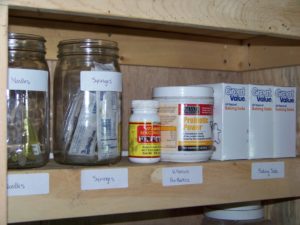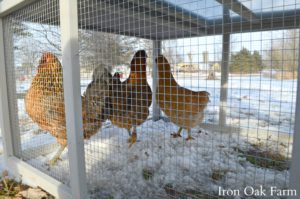 I went to Goodwill yesterday to drop off a trunk full of items to donate. The line was so long that I decided to go to lunch first and try again later. Evidently, everyone is thinking the same thing. It’s a new year and time to start fresh. I’ve seen more organizational ads and commercials this month than I have all year. The big box stores have plastic bins front and center in their displays.
I went to Goodwill yesterday to drop off a trunk full of items to donate. The line was so long that I decided to go to lunch first and try again later. Evidently, everyone is thinking the same thing. It’s a new year and time to start fresh. I’ve seen more organizational ads and commercials this month than I have all year. The big box stores have plastic bins front and center in their displays.
Last year I read the book by Japanese author Marie Kondo The Life-Changing Magic of Tidying Up. I feel like if you haven’t heard of this book then you might be living under a rock. References to it are everywhere. I noticed too that Netflix recently aired a show where Marie goes house to house helping unorganized families clear and organize their spaces.
In Kondo’s book, one of the biggest points is that items in our home should spark joy. She actually suggests that we hold each item in our home and concentrate on how it makes us feel. Her suggestion is that we only keep items in our house that make us joyful and give the rest away.
While this concept is a little out there for me…I mean…toilet paper doesn’t exactly spark joy for me, but I feel like I should keep some in the house.
 But there is something to be said for having respect for the things in your life. When you have fewer things you can take better care of the items you do have. We live in such a disposable world with inexpensive mass-produced products that it’s often easier to just buy another one of something, than taking the time to find the one you might have at home. Having respect for your things means being conscious that the worth of an item represents the time it took to earn the wages to purchase that item.
But there is something to be said for having respect for the things in your life. When you have fewer things you can take better care of the items you do have. We live in such a disposable world with inexpensive mass-produced products that it’s often easier to just buy another one of something, than taking the time to find the one you might have at home. Having respect for your things means being conscious that the worth of an item represents the time it took to earn the wages to purchase that item.
Over the past year, instead of going full “minimalistic” I’ve been evaluating our possessions based on three questions:
Do I love it?
Do I use it often?
Do I need it?
So far the process has been quite successful! Not only is our house functioning better, but I find that we’re saving money by knowing what we have (and more importantly where it is in our house). It’s also put an end to impulse purchases.
 I started thinking about how this system could be used in the homestead setting. In my opinion, it gets a little more complicated when it comes to homesteading tools. We often find ourselves trying to “rig” something up with a piece of scrap wood, a length of fencing, and some bailing twine more than I’d like to admit.
I started thinking about how this system could be used in the homestead setting. In my opinion, it gets a little more complicated when it comes to homesteading tools. We often find ourselves trying to “rig” something up with a piece of scrap wood, a length of fencing, and some bailing twine more than I’d like to admit.
Tools break in the middle of projects, so a spare can come in handy. Do we need 3 spade shovels? Well, last year the handle broke mid-project so that third shovel came in handy.
But on the other hand…how long did it take for us to find said shovel amongst all the other “spare tools” we have piled in the corner?
 How long does it take us to find a pair of pliers or a spool of wire or the box of washers amongst all the other bits and bobs that reside in the second story of our barn? And how much stress does that create?
How long does it take us to find a pair of pliers or a spool of wire or the box of washers amongst all the other bits and bobs that reside in the second story of our barn? And how much stress does that create?
I think in Homesteading the lack of stress that comes with minimalism comes before the project even starts.
If I could tell my younger self one thing before we bought our farm is to TAKE IT SLOW!!! To start small and when I’ve mastered that small task, add another small task and see how it goes.
When starting a garden, for example, it is SO tempting to plow up half the yard and buy every plant in the nursery. But more often than not, come July, the garden is too much to take care of. The weeds are 3 feet tall, nothing’s been watered and everything is leggy and strangled.
I think it is in these ideas of overachievement where minimalism can be truly useful in the Homestead. Taking really good care of a few tomatoes and some herbs is much more rewarding than losing a hundred plants to a jungle of weeds. You will save money and feel the sweet, satisfying bliss of accomplishing something and doing it well.
As far as the bits and bobs that tend to collect from projects around the homestead…I think in undertaking tasks in a slow, deliberate and thought out way, the things you need, love, and use around the homestead will be clear.
If the housing you have for your animals is sufficient and well thought out, you probably won’t need that emergency piece of fencing.
If you’re not in a rush to dig the hole with the spade shovel, then you’ll have time to replace the handle instead of keeping 3 tools of the same kind “just in case”.
…and so forth.
Minimalism isn’t for everyone, and everyone’s minimum looks different from the next. But if you’re feeling stressed out like we were about the sheer amount of things laying around and the amount of time it took to find things, then maybe look around your homestead and evaluate where you can cut back.
 Do you need to sell a few chickens to make the coop more manageable?
Do you need to sell a few chickens to make the coop more manageable?
Do you need to cut back on the number of garden beds you grow this year?
Can you dry off one or two of your milk goats so that you aren’t stressed into processing so much dairy every day?
Are their tools in your tool shed that you no longer have a use for?
Do you have multiple tools for the same purpose?
Are their things that you’re “meaning” to fix, like old lawn mowers? Chainsaws? Etc. that are just taking up space?
Think it over.
I do encourage you to donate and recycle whenever appropriate.










